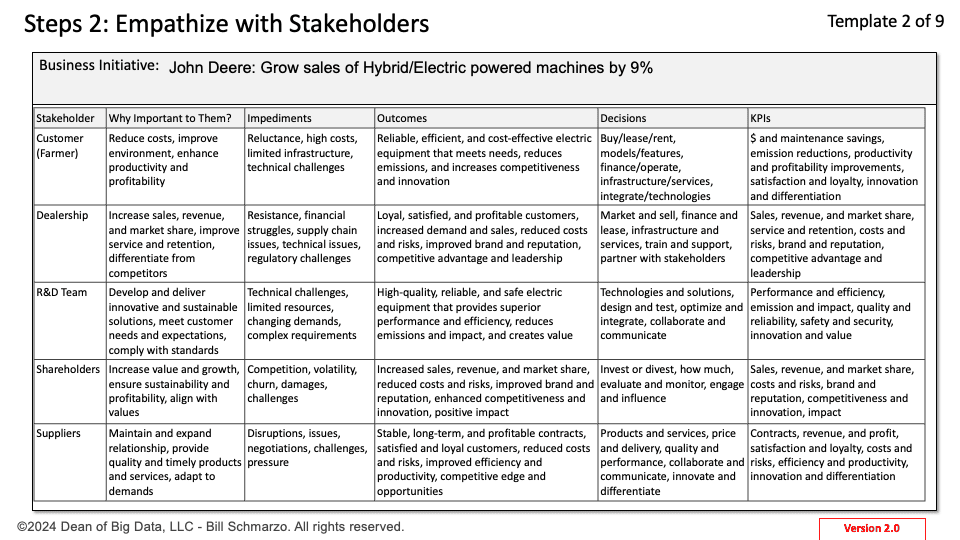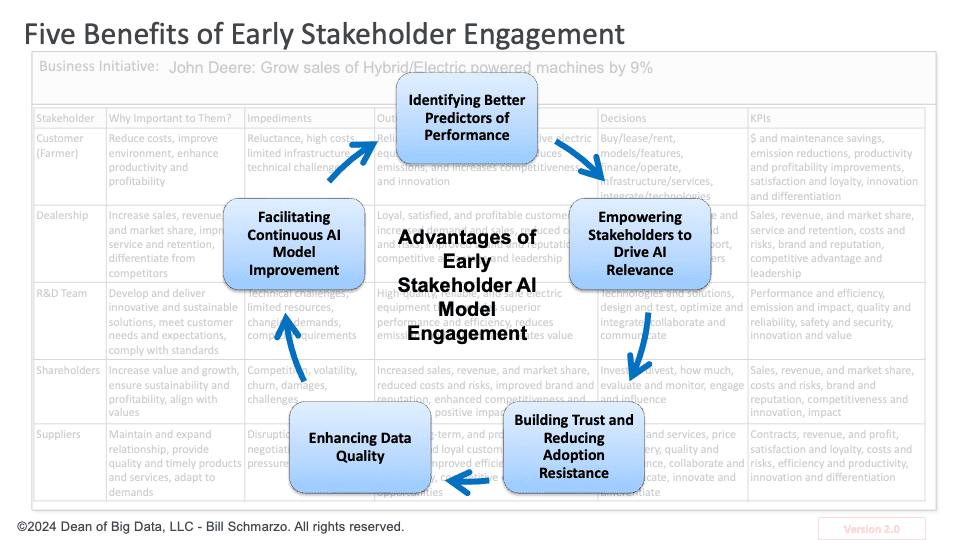
“It’s not the AI technologies that fail; it’s the organization.”
That might be a somewhat controversial viewpoint, but it emphasizes an important truth: Artificial Intelligence (AI) is a tool, not a living entity (apologies to movie enthusiasts) that will do what it is instructed and trained to do, thanks to the AI Utility Function. To ensure that AI behaves as intended, the organization must collaborate and clearly define the AI model’s intentions, desired outcomes, and key performance indicators (KPIs)/metrics to measure the effectiveness of intentions and outcomes. To ensure AI success, the AI definition and design process must involve all stakeholders impacted by the decisions and actions of the AI model and drive the necessary cross-organizational alignment.
The vital importance of early stakeholder engagement in the definition and design of our AI models is why “Empathize with Stakeholders” is the second step in the “Thinking Like a Data Scientist” (TLADS) methodology; after we clearly understand and assess the targeted business initiative or business challenge we are seeking to address with AI (Figure 1).

Figure 1: The Art of Thinking Like a Data Scientist – Second Edition
Remember, it’s never too early to start driving the organizational alignment and empowerment necessary to ensure that your AI models deliver more relevant, meaningful, responsible, and ethical outcomes.
Data Science Development Challenges
Mastering data science to leverage AI tools to transform raw data into actionable insights that enhance customer experience, products, services, and operations is a complex process fraught with numerous challenges, including:
- Dealing with messy and incomplete data necessitates sophisticated data cleaning, preprocessing, and transformation techniques to ensure data quality and reliability.
- Mastering many tools and technologies, including programming languages like Python and R, data manipulation frameworks like Pandas and SQL, and machine learning libraries like TensorFlow and Scikit-learn.
- Mastering various data engineering tasks, including data ingestion, storage, and transformation, ensures a robust and scalable data pipeline.
Yeah, a lot can go wrong on the data science journey.
To increase the chances of successfully navigating the AI/Data Science journey, one should start, deliver, and continuously learn in close collaboration with key stakeholders. Embrace a stakeholder-centric approach to data science and AI development.
Embracing Stakeholder-centric AI Development
Stakeholders are those constituents or functions (Customers, Partners, Sales, Marketing, Finance, Logistics, etc.) that either impact or are impacted by the targeted business initiative.
One of the keys to successfully navigating the “Thinking like a data scientist” process is identifying and empathizing with the key stakeholders who influence organizational value creation. Unfortunately, many AI and data science projects severely underinvest in stakeholder engagement. This disconnect leads to several issues:
- The initial requirements gathered from stakeholders may be incomplete or misinterpreted, leading to models that do not fully address the operational needs in light of the stakeholders’ intentions and desired outcomes.
- The lack of continuous stakeholder input means the model development does not reflect essential changes in operational processes or priorities.
- Stakeholders may feel a lack of ownership and connection to the project, which results in resistance to adopting the final AI solutions.
To address these issues, I use several design thinking techniques – such as Personas, Journey Maps, and Empathy Maps – to ensure that key stakeholders are involved and engaged early in defining, designing, and implementing AI. The TLADS “Empathize with Stakeholders” design canvas documents the outcomes (Figure 2).

Figure 2: “Empathize with Stakeholders” Design Canvas
Figure 2 shows the “Empathize with Stakeholders” design canvas my Iowa State University MBA students completed to support John Deere’s business initiative to increase hybrid and EV equipment sales.
- Identify Key Stakeholders: Recognize individuals or groups who either impact or are impacted by the targeted business initiative. For example, in the John Deere initiative to increase hybrid/electric product sales, stakeholders include customers, dealers, R&D teams, shareholders, and suppliers.
- Understand Business Initiative Importance: Document why the initiative is essential for each stakeholder. For instance, customers seek better cost efficiency and environmental sustainability, while dealers are interested in new revenue streams and maintaining strong customer relationships.
- Identify Stakeholder Impediments: Document any factors that might hinder stakeholders from realizing the benefits of the targeted business initiative. For example, lacking training on the resulting analytics could limit stakeholder benefits.
- Brainstorm Stakeholders’ Desired Outcomes: Capture what success looks like from each stakeholder’s perspective. For John Deere’s initiative, desired outcomes include high-quality, efficient electric machines for customers, increased sales for dealers, and innovative advancements for the R&D team.
- Identify Key Stakeholder Decisions: Determine the critical decisions stakeholders must make regarding the business initiative. For example, customers might need to choose the best models that suit their operational needs. In contrast, dealers might need to determine the new electric products’ inventory levels and marketing strategies.
- Brainstorm KPIs and Metrics: Identify the key performance indicators (KPIs) and metrics each stakeholder will use to measure progress and success. Customers might focus on cost savings and maintenance efficiency, while dealers might look at sales growth and customer satisfaction ratings.
Summary: Five Benefits of Early Stakeholder Engagement
User adoption starts during the AI model definition and development processes. This early engagement helps identify more effective machine learning features, uncover potential usability issues, and align the AI model outputs with user needs and expectations. The five benefits of early stakeholder engagement include (Figure 3):
- Identifying Better Predictors of Performance. Stakeholders possess invaluable “tribal” knowledge about the variables, metrics, and features that can serve as better predictors of performance. Their hands-on experience and domain expertise provide critical insights for crafting a more holistic and relevant AI Utility Function.
- Empowering Stakeholders to Drive AI Relevance. Involving stakeholders early in the model definition and development phases fosters a sense of ownership and ensures that the AI models address real business needs. This ultimately leads to more robust stakeholder adoption of the analytic insights.
- Building Trust and Reducing Adoption Resistance. Early involvement of stakeholders helps build trust and reduce resistance to change. When stakeholders are part of the AI definition and development process, they are more likely to understand and trust the models, leading to smoother implementation and higher acceptance rates.
- Enhancing Data Quality. Stakeholders can provide critical insights into data sources and quality. Their input can help identify gaps, inconsistencies, and areas for improvement in the data, ensuring that the models are built on high-quality, comprehensive datasets.
- Facilitating Continuous AI Model Improvement. Stakeholders’ feedback is vital for fine-tuning AI models to support operational execution. Ongoing collaboration ensures that the AI models remain relevant and practical, ultimately leading to improved operational outcomes.

Figure 3: Five Benefits of Early Stakeholder AI Model Engagement
Understanding and empathizing with stakeholders is crucial for the success of AI initiatives. Organizations can use stakeholder insights early and continuously to create more accurate and relevant AI models.
